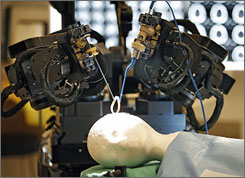
Robotic surgery is the use of robots in performing surgery.

(ROBOTIC SURGERY)
Three major advances aided by surgical robots are :
i.)Remote Surgery

(REMOTE ROBOT SURGERY)
ii.)Minimally invasive Surgery

(Minimal Invasive Robot Surgery)
iii.)Unmanned Surgery.

(UNMANNED ROBOT SURGERY)
ADVANTAGES OF ROBOTIC SURGERY :Major potential advantages of robotic surgery are
i.)Precision and Miniaturization.
ii.)Articulation beyond normal manipulation and
iii.)Three-dimensional magnification.
Some surgical robots are autonomous, not under control of a surgeon.

(VARIOUS CONCEPTS IN AUTOMATIC CONTROL ROBOTS)
HISTORY OF ROBOTIC SURGERYIn 1985 a robot, the PUMA 560, was used to place a needle for a brain biopsy using CT guidance.

(PUMA 560 ROBOT)
In 1988, the PROBOT, developed at Imperial College London, was used to perform prostatic surgery.

(PROBOT ROBOT)
The ROBODOC from Integrated Surgical Systems was introduced in 1992 to mill out precise fittings in the femur for hip replacement.

(ROBODOC ROBOT HIP SURGERY)
Further development of robotic systems was carried out by Intuitive Surgical with the introduction of the da Vinci Surgical System and Computer Motion with the AESOP and the ZEUS robotic surgical system.

(DA VINCI SURGICAL SYSTEM ROBOT)
Intuitive Surgical purchased Computer Motion in 1994 and discontinued development of the ZEUS System.

DA VINCI SURGICAL SYSTEM

The da Vinci Surgical System is comprised of three components: a surgeon’s console, a patient-side robotic cart with four arms manipulated by the surgeon, and a high-definition 3D vision system. Articulating surgical instruments are mounted on the robotic arms which are introduced into the body through cannulas. The surgeon’s hand movements are scaled and filtered to eliminate hand tremor then translated into micro-movements of the proprietary instruments.
 (DA VINCI ROBOT SYSTEM, A- SURGEON CONSOLE, B- 3D VISION SYSTEM, C- PATIENT SIDE ROBOT CART WITH 4 ARMS)
(DA VINCI ROBOT SYSTEM, A- SURGEON CONSOLE, B- 3D VISION SYSTEM, C- PATIENT SIDE ROBOT CART WITH 4 ARMS)
(DA VINCI ROBOT ARMS)

(VIEW OF DA VINCI ROBOT SYSTEM SURGERY)
The da Vinci System is FDA cleared for a variety of surgical procedures including surgery for prostate cancer, hysterectomy and mitral valve repair and used in more than 800 hospitals in the Americas and Europe. The da Vinci System was used in 48,000 procedures in 2006 and sells for about $1.2 million.
In May 1998, Dr. Friedrich-Wilhelm Mohr using the Da Vinci surgical robot performed the first robotically assisted heart bypass at the Leipzig Heart Centre in Germany.
In 2001, Marescaux used the Zeus robot to perform a cholecystectomy on a patient in Strasbourg, France while in New York.
The first unmanned robotic surgery took place in May 2006 in Italy.
Applications Cardiac surgery
Cardiac surgeryEndoscopic coronary bypass surgery and mitral valve replacement have been performed. Totally closed chest, endoscopic mitral valve surgeries are being performed now with the robot.
 Gastrointestinal surgery
Gastrointestinal surgeryMultiple types of procedures have been performed with either the Zeus or da Vinci robot systems, including bariatric surgery.

(GASTROINTESTINAL BARIATIC ROBOT SURGERY)

(SURGICAL ROBOT PARTS)
GynecologyReproductive surgery and ablative surgery including hysterectomy have been performed.

 Neurosurgery
NeurosurgerySeveral systems for stereotactic intervention are currently on the market.

 Orthopedics
OrthopedicsThe ROBODOC system was released in 1992 by the Integrated Surgical Systems, Inc.
 Pediatrics
PediatricsSurgical robotics has been used in many types of pediatric surgical procedures including:
i.)Tracheoesophageal fistula repair,
ii.)Cholecystectomy,
iii.)Nissen fundoplication,
iv.)Morgagni hernia repair,
v.)Kasai portoenterostomy,
vi.)Congenital diaphragmatic hernia repair, and others.

(SURGICAL ROBOT ARMS)
On January 17, 2002, surgeons at Children's Hospital of Michigan in Detroit performed the nation's first advanced computer-assisted robot-enhanced surgical procedure at a children's hospital.
For more Robotic Surgery Articles, Visit
1.)
Robotic Surgery Institute2.)
Cardiac Surgery Associates



























